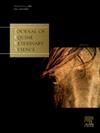纯血马比赛时间和排名的遗传参数估计。
IF 1.3
3区 农林科学
Q2 VETERINARY SCIENCES
引用次数: 0
摘要
本研究旨在估算以秒为单位的比赛时间和最终排名的遗传参数,并分析与比赛时间相关的遗传趋势。研究使用的数据集包括圣保罗赛马俱乐部的 6,213 匹纯血马在 1,000 米、1,600 米和 2,000 米距离上的 23,290 次比赛时间和最终排名记录。我们的模型将比赛年份、马匹性别、比赛级别、赛道条件、马匹体重和年龄的线性效应以及年龄的二次效应作为固定协变量。随机效应包括直接加性遗传效应、动物永久环境效应和残差效应。遗传力估计值从 0.01±0.03 到 0.17±0.04(比赛时间);0.04±0.03 到 0.09±0.04(最终排名),重复性从 0.19±0.02 到 0.37±0.02(比赛时间)和 0.15±0.02 到 0.23±0.04(最终排名)。比赛时间与排名之间的估计育种值的皮尔逊相关性为-0,027±0.16 至 0.84±0.01。在分析距离为 1000 米的比赛的遗传趋势时,我们观察到比赛时间随着时间的推移而缩短。然而,在 1,600 米和 2,000 米的比赛中,时间减少的模式并不明显。比赛时间为选择提供了一个更有希望的响应,尤其是在较短的比赛中。针对比赛时间进行选拔预计会对最终排名产生更大的间接影响。遗传趋势表明,多年来遗传进展有限;因此,最好重新评估当前的选拔过程。本文章由计算机程序翻译,如有差异,请以英文原文为准。
Estimation of genetic parameters for racing time and ranking in Thoroughbred horses
This study aimed to estimate genetic parameters for race time in seconds and final ranking, as well as to analyze the genetic trends associated with race time. The study utilized a dataset consisting of 23,290 records of race times and final ranks at distances of 1,000, 1,600, and 2,000 m from 6,213 Thoroughbred horses from the São Paulo Jockey Club. Our model considered the year of the run, animal sex, race class, track conditions, the linear effect of horse weight and age, and the quadratic effect of age as fixed covariates. Random effects included direct additive genetic, animal permanent environmental, and residual effects. Heritability estimates ranged from 0.01±0.03 to 0.17±0.04 (race time); 0.04±0.03 to 0.09±0.04 (final ranking), and repeatability from 0.19±0.02 to 0.37±0.02 (race time) and 0.15±0.02 to 0.23±0.04 (final ranking). Pearson's correlations of estimated breeding values between race time and ranking ranged from -0,027±0.16 to 0.84±0.01. When analyzing the genetic trend for races at a distance of 1,000 m, we observed a decrease in race time over time. However, for races at 1,600 and 2,000 m, a clear pattern of time reduction was not apparent. Race time offers a more promising response to selection, particularly in shorter races. Selecting for race time is expected to have a greater indirect impact on final rank. Genetic trends have revealed limited genetic progress over the years; therefore, it is advisable to reevaluate the current selection process.
求助全文
通过发布文献求助,成功后即可免费获取论文全文。
去求助
来源期刊

Journal of Equine Veterinary Science
农林科学-兽医学
CiteScore
2.70
自引率
7.70%
发文量
249
审稿时长
77 days
期刊介绍:
Journal of Equine Veterinary Science (JEVS) is an international publication designed for the practicing equine veterinarian, equine researcher, and other equine health care specialist. Published monthly, each issue of JEVS includes original research, reviews, case reports, short communications, and clinical techniques from leaders in the equine veterinary field, covering such topics as laminitis, reproduction, infectious disease, parasitology, behavior, podology, internal medicine, surgery and nutrition.
 求助内容:
求助内容: 应助结果提醒方式:
应助结果提醒方式:


